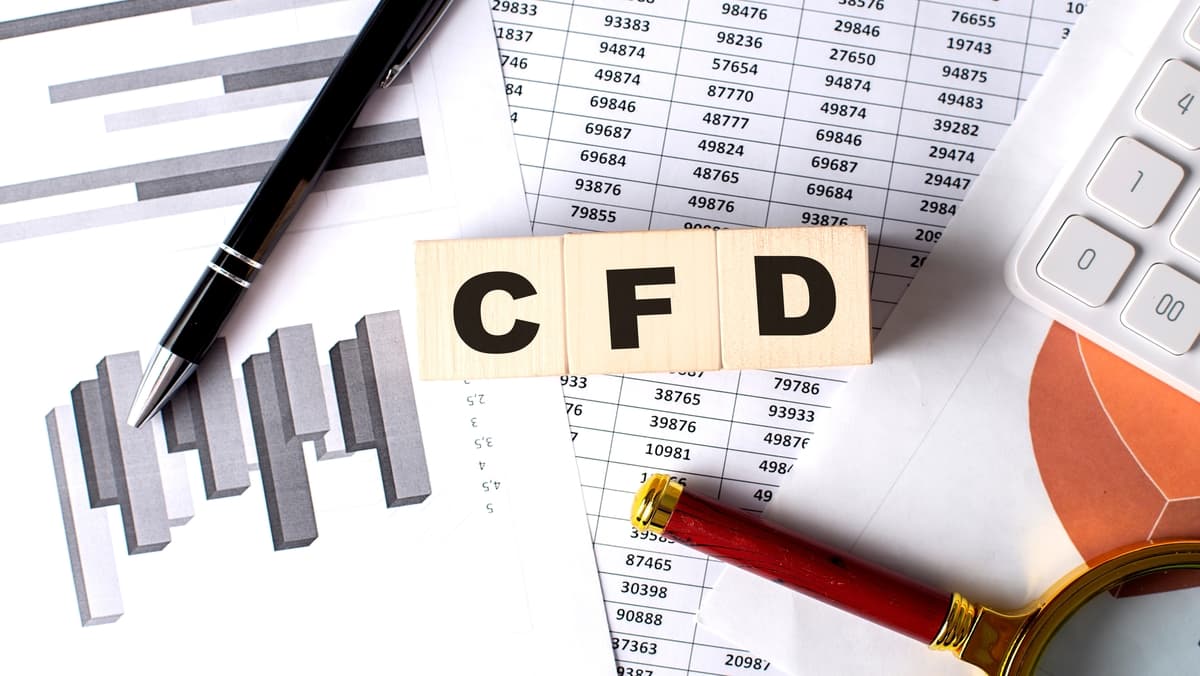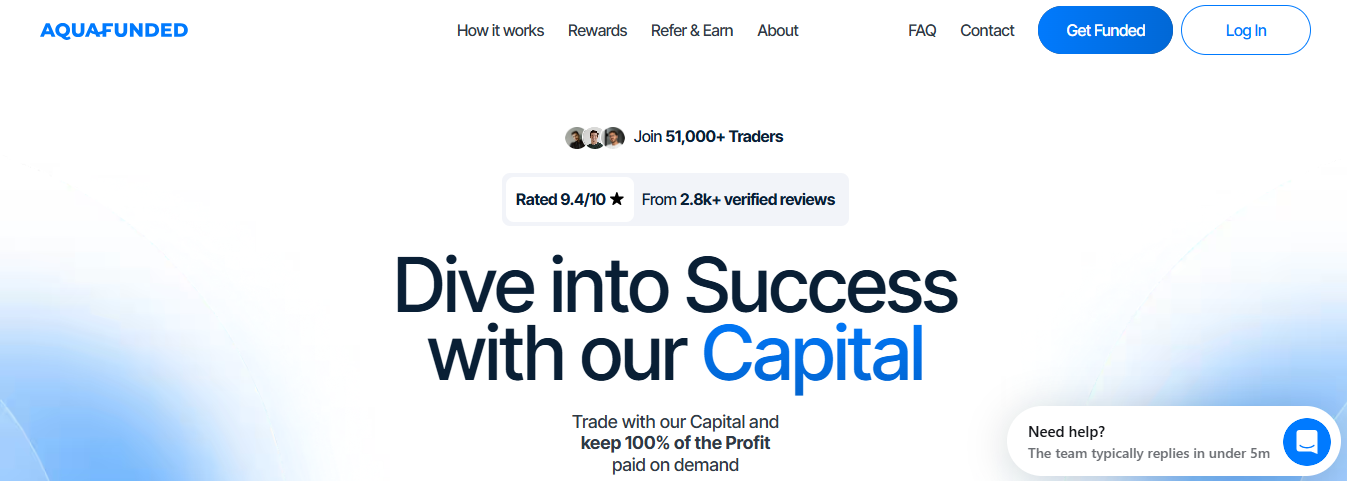What Are CFD Indices, Risks, Benefits, and Trading Strategies
Learn what CFD Indices are, their benefits, risks, and smart trading strategies to help you make informed investment decisions.

You watch the index tick higher as an economic release hits the screen and wonder how to turn fast moves into steady results. CFD Indices play a central role in Day Trading Indices, letting traders access S&P 500, NASDAQ, FTSE, and DAX with leverage, shorting, and index futures exposure while testing skills in price action, technical analysis, and risk management.
If your goal is professional trading with a funded account, this guide breaks down key concepts, including spreads, margin, liquidity, order types, and practical trading strategies, to help you achieve it.
AquaFunded's Funded Trading Program offers a simple path: prove consistent performance under real market conditions, gain capital to trade larger sizes, and keep firm risk controls so you can move from practice to professional trading.
Summary
- Index CFDs package broad-market exposure into a single trade, for example, the S&P 500 covers 500 companies, which reduces idiosyncratic stock risk and smooths single-company shocks.
- Leverage magnifies outcomes and is a primary driver of failure, noting that over 80% of retail CFD accounts lose money; therefore, many traders should limit their risk to roughly 0.5 to 1 percent of their capital per trade.
- Operational frictions become critical as scale increases, because traders are advised to model financing and carry for multi-day holds, for example, by testing 3, 5, and 10-day scenarios to see how financing erodes net returns.
- Execution and slippage are measurable costs; therefore, measure the typical spread and realized slippage across the last 12 similar news releases, and validate live fills with a small-scale test before scaling.
- Discipline and repeatability outperform improvisation; aim to document and maintain an edge across a series of trades. For example, only scale after 30 consecutive, documented trades that confirm your slippage and expectancy.
- Backtests with small samples are unreliable; treat patterns with fewer than 100 occurrences as conditional evidence and downsize positions until you reach robust sample sizes.
- This is where AquaFunded's Funded Trading Program fits in, by centralizing real-time margin monitoring and automated stop routing to help maintain consistent position sizing and reaction times during fast markets.
What Are CFD Indices

CFD indices are contracts that let you bet on an index’s price moves without buying the underlying shares, so you capture directional gains or losses while holding a single position. They bundle market-wide exposure, let you trade in both directions, and magnify results through margin, making them efficient tools for short-term traders and tactical portfolio plays.
What does trading an index CFD actually do?
1. Ownership-free speculation
Trading an index CFD means you take a position linked to the index level rather than acquiring any of the component stocks. You benefit if your forecast about the index’s direction is correct, and you avoid custody, settlement, and dividend-handling that come with owning each share. Think of it as holding a single claim on the index’s movement, not dozens of individual stocks.
2. Broad-market exposure in one instrument
Index CFDs package many companies into a single trade, which smooths idiosyncratic noise and gives you a macro view rather than a stock-by-stock view. According to Dukascopy Europe IBS AS, exposure to entire market segments, such as the S&P 500 and FTSE 100, brokers list index CFDs precisely to offer that segment-level access, allowing you to trade a sector or national market with a single order.
3. Built-in diversification effects
Because an index is a composite of many stocks, the price move reflects the collective shift, which can reduce the risk tied to any single company. That structure gives you a natural hedge: while single-stock holdings can swing wildly on company news, the index tends to absorb those shocks. For example, using an index that tracks the S&P 500 provides exposure to the large-cap US market through the S&P 500 Index, which covers 500 companies. Hence, a single execution represents a broad slice of the market rather than a lone bet.
How can you profit from both up and down markets?
4. Go long or short, deliberately
You can buy a CFD when you expect the index to rise, or sell it when you desire a decline, so profit opportunities exist in both directions. Your return equals the difference between entry and exit multiplied by your position size, less costs, so accuracy and timing matter. Shorting an index can act as a tactical hedge against equity holdings, but it requires the same discipline as taking a long position.
What role does leverage play?
5. Leverage and margin explained
CFD providers let you open larger positions than your deposit by requiring only margin up front, which increases both upside and downside because profit or loss is computed on the full position size. You must monitor margin levels and stop-out rules, as a small adverse move can quickly wipe out a leveraged trade. Treat leverage like a multiplier, not free money.
How do index CFDs interact with portfolio risk?
6. Tactical offsets and portfolio symmetry
Traders often use index CFDs to shield portfolios or to capture directional moves while keeping capital liquid. In a falling market, a short index CFD can offset losses from long equity holdings; when markets rally, the long CFD amplifies gains. That symmetry makes index CFDs a practical tool for active risk management, provided position sizing and stop rules are disciplined.
When traders chase quick breakouts, what usually goes wrong?
7. Common behavioral failure mode
A consistent pattern emerges around significant macro moves: traders pile into breakout trades after a currency or economic surprise, expecting continuation, but then get shaken out when volatility reverses. That mistake is emotional and timing-based, not technical—people trade conviction without rehearsing exit paths, and the result is predictable drawdown. I’ve observed this pattern among short-term traders who scale their position size based on confidence rather than risk limits, and it explains many rapid account declines.
Most teams handle tactical hedging with spreadsheets and manual margin checks because it feels familiar and low-cost, which works at small scale. As position counts grow and market speed increases, margin calls and execution delays create friction and surprise losses. Solutions like AquaFunded offer centralized margin monitoring, real-time execution tools, and automated risk alerts, enabling traders to compress reaction time and maintain consistent position sizing while preserving oversight.
That familiar approach is understandable, but the hidden cost is lost control when markets move fast; automated risk tools restore that control without forcing a wholesale process change.
Curiosity loop
What traders think they know about using CFDs to manage risk often collides with a different, harsher reality.
Benefits and Risks of CFD Indices

CFD index trading gives you flexible ways to express a market view quickly, while concentrating capital and using short positions for tactical plays. Still, those same features create outsized operational and behavioral risks that must be managed deliberately. Below, I outline the real advantages and real dangers you need to plan for, each presented with fresh, practical detail so you know exactly what changes when you choose index CFDs.
Pros
1. Profit from falling markets, without borrowing stock
You can short an index CFD and capture declines without arranging stock loans or dealing with settlements. Practically, this means you can hedge or take a bearish stance in minutes and use short exposure to protect a long portfolio during volatile periods. The real edge shows up when you combine short index positions with position sizing rules that limit exposure to single macro events, because shorting is a tactical, not a permanent, stance.
2. Leverage that preserves working capital
CFD margin enables you to control larger index exposure while maintaining your cash liquidity, supporting diversified and active trading. Keep in mind that IG International, states "CFDs allow you to trade on margin, meaning you can open a position by paying just a fraction of its full value," and that fact changes portfolio construction: you can hold several noncorrelated intraday bets instead of one oversized position. Use that power for rotation and tightening of risk per trade, not for multiplying position size after a win streak.
3. Familiar order mechanics, with index-scale contract sizing
Index CFDs mirror the underlying market’s tick sizes and contract units, so execution and sizing feel like regular trading. The difference to exploit is in microstructure: know the index’s tick value and typical spread during news events, because slippage matters more when you trade many contracts. Treat the CFD like a synthetic stock bundle whose execution quirks you must measure, then design entries and exits around those measurements.
4. One platform, many asset classes
Having equities, indices, FX, commodities and crypto on a single interface simplifies rebalancing between instruments and rolling hedges intra-session. That convenience becomes an operational advantage when you can quickly convert a directional thesis into a cross-asset hedge, for example, by selling an index CFD while buying commodity exposure that historically offsets the same risk, all without transferring money between accounts.
5. Tactical hedging and overlay strategies
You can layer short index CFDs against a long portfolio as a temporary shield, creating symmetric outcomes versus selling underlying holdings outright. The practical discipline is to size the hedge in relation to the portfolio beta and to establish pre-planned exit rules, because a hedge should be a measured offset, not a second speculative bet.
6. Low-friction practice before real capital
Demo accounts allow you to practice fills, order types, and fast exits with market replay and time-of-day simulations, which is essential for index day trading. Use demos to stress-test your execution plan during economic releases and to measure slippage per order type. Then, hard-code those slippage figures into your risk model so that live trades match expectations.
Cons
1. Real-world loss rates and behavioral pressure
Be straightforward about the math, and plan accordingly. Keep in mind that IG Internationalreports that "over 80% of retail investor accounts lose money when trading CFDs," which is a symptom of leverage misuse and weak trading discipline. The failure mode I repeatedly observe is slow, creeping risk: after a few wins, traders ratchet up their contracts, lose a single session, and then face margin stress that forces them to make poor exits. Stop this by predefining drawdown limits and position-size bands tied to realized volatility.
2. No ownership, no corporate benefits
Because CFDs are synthetic, you do not receive shareholder rights or direct dividend ownership. The practical consequence is that tax and corporate action handling differs by jurisdiction and broker, so confirm the adjustment mechanics for dividends, roll dates, and corporate events before sizing positions that sit through ex-dividend periods.
3. Overnight and financing exposures
Holding leveraged index positions across sessions creates a financing cost that compounds over time. This is not abstract: financing is calculated on position value and daily rates, so multi-day carries can erode returns faster than you expect if you treat CFDs like buy-and-hold investments. For multi-day tactical exposure, explicitly model carry into profit targets and run scenario tests for 3-, 5-, and 10-day holds to see how financing changes net outcomes.
Practical risk controls and execution details you will actually use
How should you size and place trades to avoid common trading pitfalls?
Use volatility-based sizing, for example, a risk of 0.5 to 1 percent of available capital per trade, and calculate the contract count based on the average true range, rather than a fixed contract number. Place limit entries where liquidity tests show tight fills, and favor limit exits for planned losses to prevent slippage from turning a small miss into a catastrophic margin event.
What hidden operational frictions disrupt well-planned strategies?
Execution latency during market opens, staggered global session hours, and broker-specific spread widening are the small failures that compound. The pattern is consistent: manual margin checks and spreadsheets work until they no longer do, then responders are too slow. That is why many traders who scale from hobby to funded accounts hit unexpected stoppages when correlated positions trigger margin calls.
Status quo disruption: why manual margin monitoring fails, and what changes
Most traders track exposures with spreadsheets and ad hoc alerts because it is familiar and requires no new systems. That works for a few positions, but as you layer intraday entries and temporary hedges, spread and carry interact, rendering static spreadsheets obsolete. Platforms like Funded Trading Program centralize real-time margin, provide automated stop routing, and surface financing costs per position, compressing reaction time and keeping size within safe bands while preserving execution agility.
A few tactical checks you can implement now
- Measure typical spread on your target index during the specific hour you trade, and write that as a fixed cost in your profit model.
- Backtest trade exit rules, including slippage and financing, not just ideal fills.
- Treat demo results as conditional; move to small live size to validate slippage and behavior under real fills before scaling.
I know the psychology here: confidence grows after two wins, and with it position size, until a single gap wipes a month of gains. That pressure is exhausting and avoidable if you program hard limits around drawdown and real fill costs.
Turn your trading skills into substantial profits without risking your own capital. AquaFunded gives you access to accounts up to $400K with the most flexible trading conditions in the industry — no time limits, easy-to-achieve profit targets, and up to 100% profit split; learn more about our funded trading program. Join over 42,000 traders worldwide who've already collected more than $2.9 million in rewards, all backed by a 48-hour payment guarantee and instant funding or customizable challenge paths.
That advantage looks straightforward now, but the part that breaks most traders is quieter and far harder to recover from.
Related Reading
- What Is Considered a High VIX
- What Is a Trading Session
- What Is Support and Resistance in Trading
- What Is a Stock Market Index
- How to Trade S&P 500 Futures
- How Is the Dow Jones Calculated
- Trading the DAX
- Asset Class Correlation
How to Day Trade CFD Indices

Day trading CFD indices demands a tight, repeatable process: prepare with focused research, set conservative targets, size positions to volatility, and enforce risk rules while keeping emotions under control. Below are six concrete, reworded action items you must implement to trade intraday indices reliably.
1. Use AquaFunded
AquaFunded enables skilled traders to access funded accounts, allowing them to grow their position size without risking personal capital. With account tiers of up to $400,000, flexible challenge routes, and high profit splits, AquaFunded provides a valuable opportunity for traders to grow their positions. Treat a funded program as a structured bridge: start with a small, time-boxed plan to prove execution and control over slippage, then scale according to predefined rules rather than intuition. Operationally, record every trade during the challenge, measure realized spread and fill rates, and only increase contract size when your edge holds across 30 consecutive, documented trades. That discipline converts a funding perk into a scaling engine, rather than a temptation to overleverage.
2. Do rigorous research and rehearse setups
What most traders skip is the repeat rehearsal of entry and exit behavior under real fills; don’t be one of them. Build a checklist that includes pre-market macro cues, index-specific liquidity windows, and the three order types you will use that day. Then, run market-replay sessions until your entries and stops match the live fills. Study internals, because headline moves can hide divergence, for example, the S&P 500, which represents exposure to S&P 500 Index, often moves on breadth shifts that technicals alone miss. Track how often your setups fail during economic releases, then reduce size or switch to limit-only execution in those windows. Practice narrows risk; repetition turns instinct into procedure.
3. Set modest targets and clear stop rules
Small, consistent gains win more often than chasing lopsided returns. Define a per-trade profit target tied to average true range, and pair it with a stop that limits loss to a fixed percent of the account or funded allocation. When volatility spikes, shrink target-to-stop ratios and accept more trades with lower size, because attempting the same profit with wider range is a subtle way to lose. I have observed the same failure pattern repeatedly: traders scale after two wins, only to see a single gap event wipe out those gains; pre-authorized size bands halt that drift. If you collect small wins in that compound, you are trading sustainably.
4. Execute one strategy and make it boring
The advantage of a single, well-tuned approach is repeatability. Pick a time-of-day and a setup, measure entry slippage and average hold time, then hard-code position sizing from realized volatility rather than confidence. For example, when dealing with technology-heavy indices, remember the NASDAQ-100 tracks 100 companies, NASDAQ-100 Index, which concentrates risk and requires tighter stops during earnings season. Treat your strategy like a thermostat, not an on-off switch: minor, automatic adjustments keep temperature steady; impulsive overrides cause crashes.
5. Apply merciless risk management
Make loss limits explicit and automatic. Use volatility-based contract sizing, a daily drawdown ceiling, and a weekly review that forces you to drop back to demo for two full trading days after a preset loss. The hidden cost of informal rules manifests as creeping position size and recovery-chasing, which is the primary reason accounts blow up. When the margin moves against you, accept being flat and reset. That behavior preserves optionality, and optionality is the only real edge in fast-moving index CFDs.
6. Control the human element
Emotion is not an abstract weakness; it is a quantifiable failure mode. Traders become attached, average into losing trades, and then rationalize their losses. This pattern is observed across both retail and funded programs: after a short winning streak, position size often increases while risk controls are relaxed, resulting in acute drawdowns. Build anti-emotion rules, for example, a hard rule that you never add to a losing position and a ritual pause of five minutes before any manual override. Use simple cues, such as a checklist with three binary items, to encourage rationality under pressure.
Most teams use spreadsheets and ad hoc notes because they feel familiar and low-cost. That works when you trade a few small bets, but as positions multiply, those methods fragment, and reaction time suffers. Platforms like AquaFunded centralize funded account metrics, automate stop routing, and provide real-time visibility into financing costs, helping traders maintain size within planned bands while remaining nimble from moment to moment.
Analogy to close the loop: treat your trading plan like a cockpit checklist, not a menu; following it saves careers, improvisation costs them.
The frustrating part? This is only the setup; the real test is converting these rules into disciplined executions under live pressure.
Related Reading
- Where to Place Stop Loss
- Position Size Formula
- Scalping vs Day Trading
- What Is Index Pricing
- Volatility Indicator MT4
- What Are the Advantages of CFD Trading Over Normal Trading
- How to Profit From CFD Trading
- What Is a Fair Value Gap in Trading
- How to Calculate Stock Volatility
- Difference Between Nasdaq and S&P
- FTSE vs MSCI
7 Trading Strategies for CFD Indices

You need a compact toolkit of seven distinct tactics, each matched to a specific time frame, liquidity profile, and clear entry, exit, and sizing rules. These are practical, rehearsal-ready methods you can practice and measure, not ideas to mix until they break your account; that popularity is understandable because 7 Secret CFD Trading Strategies: The Worldwide Growth of Cfds Why Are Cfds So Popular?, notes "CFDs have grown in popularity due to flexibility to profit from rising or falling markets, leverage allowing large trades with small deposits, and avoidance of stamp duty on share trades."
1. News trading
Set a short pre-commit template for every scheduled release: target, maximum size, allowed slippage, and a strict post-event timeout. Trade only with predefined order types, for example, placing stop-entry orders a few ticks beyond consensus surprises, or use limit retests if your broker consistently widens spreads. Measure realized slippage and volatility for the specific index across the last 12 similar releases and reduce the size when realized volatility exceeds your historical 75th percentile. The pattern is clear, across retail and funded traders: emotional follow-through after one or two wins leads to oversized entries during news, which is how quick gains vanish. Make the template non-negotiable so that emotion cannot scale position size.
2. Trading with technical analysis indicators
Pick one signal generator and one confirmation tool, then quantify them. For example, use a 21-period moving average as your trend filter and an RSI threshold for entry confirmation, but backtest those exact parameter sets for the index and the hour you trade. Convert indicators into rules: "Entry after MA slope positive, RSI above 55, stop at ATR(14) x 0.8, target 1.5x risk." Track two metrics each week, hit rate and average R, and retire parameter sets that fail to maintain a stable edge. Indicator stacking may seem sophisticated, but it often dilutes decision-making; instead, opt for parsimony and treat each indicator as a lab-tested hypothesis.
3. Price action trading
Trade price structure, not pattern fetish. Define the precise bar shapes and context you accept, for example, a one-hour engulfing candle that also flips the most recent swing high, combined with a clean higher-timeframe trend. Backtest the pattern for a 6- to 12-month window and record both the sample size and expectancy. If the sample size is below 100 occurrences, treat the results as conditional and adjust the sample size accordingly. This approach forces you to measure whether that repeating visual pattern actually produces an edge, rather than relying on an impression from a single chart.
4. Breakout trading
Require two confirmations before committing: a volatility acceleration (measured as ADX or ATR expansion) and either a volume-like proxy or a retest that holds within a defined tick band. Use layered entries, for instance, 50 percent of the intended size on breakout, 50 percent on a successful retest, with a combined stop sized to account for the worst-case spread inflation. False breakouts are predictable failure modes, often occurring at market open or just after major futures rolls. Control size and use a forced reversion rule: if your first tranche is stopped and the intraday structure flips, do not re-enter that breakout.
5. Hedging
Use CFDs to create tactical overlays sized to the portfolio's beta, rather than relying on intuition. The strategy of combining long and short equity positions to lock in a view while hedging risk is an explicit tactic, as described in 7 Secret CFD Trading Strategies: The Worldwide Growth of Cfds Why Are Cfds So Popular?, which outlines long-short equity approaches. Translate that into rules: compute the hedge as the portfolio beta times the expected index move, cap the hedge to a percentage of total risk capital, and predefine the unwind condition, for example, closing once implied volatility reverts to a target. The practical failure is hedges turning into speculative layers; enforce sunset rules so the hedge performs as insurance, not a second bet.
6. Scalping
Treat scalping like precision work. Choose indices and sessions with the tightest typical spread. Instrument your platform for sub-50ms latency if you plan to execute many trades, and automate the repetitive tasks. Manual scalping hits a hard limit: you will miss fills and reaction windows as your workload rises, which is why traders with heavier volumes turn to simple bots that execute a fixed two-step routine. Perform a micro-backtest: collect 500 live scalps, measure the average slippage, and enable automation only after the bot replicates your human fill profile within 10 percent accuracy.
7. Day trading
Design an intraday script that you run before the open and again at the first hour. Check liquidity bands, mark the two pivot levels you accept, and set a daily stop-loss in both dollars and as a percentage. Pick one or two time-of-day setups and practice them until your win rate and average hold time stabilize. If your daily drawdown triggers, force a documented cooling-off period and a two-day demo reset. The common failure is mission creep, where traders expand rules after a few good sessions, lock the plan, and only change parameters after a statistically significant test.
Most traders operate with ad hoc checks, spreadsheets, and mental limits because those methods feel familiar and require no new tools. That approach works for a handful of positions, but as you add intraday entries, hedges, and event bets, manual oversight creates delays, margin surprises, and inconsistent rule enforcement. Platforms like Funded Trading Program centralize position metrics, automated stop routing, and real-time financing visibility, helping traders enforce sizing bands and reduce reaction time without adding operational overhead.
A short analogy: think of these strategies as separate instruments in a mechanic’s kit, not a single, overloaded power tool; choose the one that fits the screw, not the one that feels most exciting.
That neat plan sounds final, but the next part reveals the one structural shift that forces traders to stop risking their own capital before they scale.
Join Our Funded Trading Program Today - Trade with our Capital and Keep up to 100% of the Profit.

If you trade CFD indices and want to scale while keeping control of your process, consider AquaFunded as a disciplined way to test larger intraday position sizes without adding personal capital. Programs that allow you to Trade with our Capital and Keep up to 100% of the Profit exist. Trying one with conservative sizing, strict stop rules, and measured execution can turn a repeatable edge into a dependable income path.
Related Reading
- CFD Leverage
- Breakout Trading Strategy
- Gap Fill Strategy
- NFP Trading
- Swing Trading Patterns
- Dow Jones Index vs S&P 500
- FTSE 100 vs S&P 500
- CFD Market Hours
- Spot Trading vs Futures Trading


